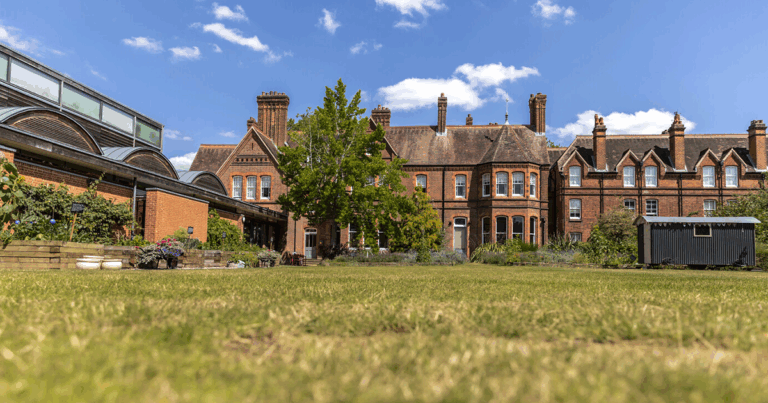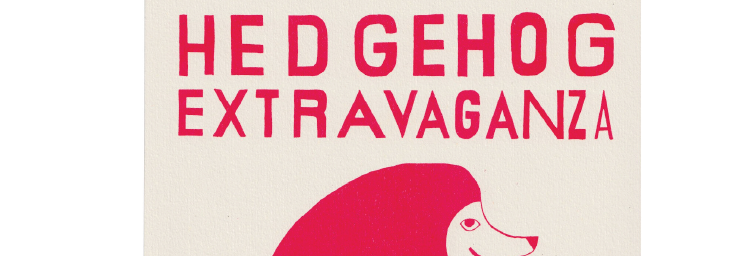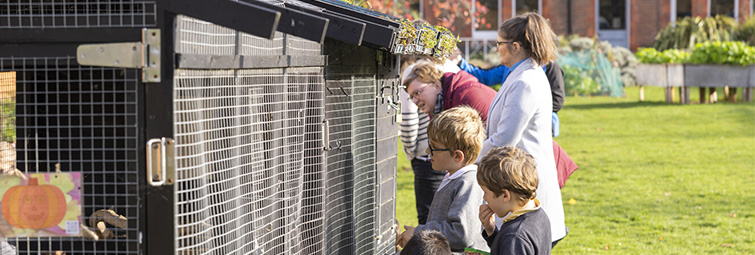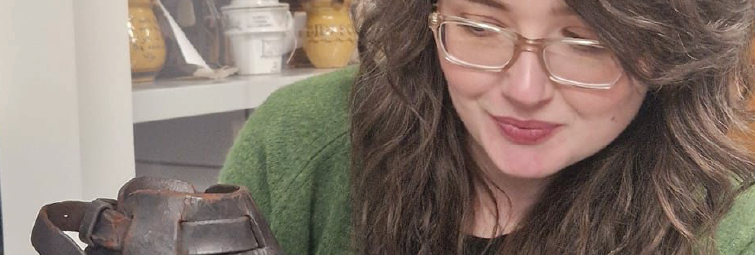Finding Common Ground
Samwel Nangiria Taresero, a Maasai community leader, recently visited The MERL and exchanged ideas with curator Dr. Ollie Douglas about how land is managed and shared, both in England and Tanzania.
-
Author
- Ollie Douglas
-
Published Date
- October 2, 2024

Last month, I spent a day with Samwel Nangiria Taresero (Sam), a Maasai human rights defender who was visiting the UK from his home in Loliondo, Tanzania.
Traditionally, the Maasai are pastoralists—people with a culture and mode of subsistence centred on keeping livestock—whose homeland spreads across Kenya and Tanzania, in East Africa. Sam travelled to the UK as part of a community healing project—Maasai Living Cultures—focussed on artefacts held at the Pitt Rivers Museum, Oxford, and the disconnection of Maasai people from their land and heritage as a result of British colonialism.
Previously, I told Sam about work I was doing to identify threads of East African history at The MERL, exploring the museum’s colonial links. Sam was keen to hear more and to understand the ideas shaping contemporary conversations about UK land access, farming, and nature. Sam’s visit also allowed him to share his thoughts about land rights and how traditional ways of thinking about the world remain essential for shaping a better future.A visit to the Chilterns
When a sheep farmer’s son-turned-curator (me) and a pastoralist-turned-indigenous rights campaigner (Sam) meet, it feels only right to take some time to look at livestock.What better excuse does anyone need to go to a local farm and see wonderful native breed cattle?
So, we set off to visit local tenant farmer James Norman at nearby Path Hill Farm in Whitchurch-on-Thames. James is a committed member of Pasture For Life and a strong advocate for organic farming, nature recovery, and land reform.
The ground that James farms at Path Hill forms part of the Hardwick Estate, which is owned by the organic pioneer Sir Julian Rose. Hardwick converted to organic in the mid-1970s and has become a powerful example of a private estate keen to pursue an inclusive ethos, grounded in principles of self-reliance, social responsibility, community management, and wellbeing.
James explained that although he trained in traditional agriculture, he embraced organic ideas soon after graduating. He has farmed organically for over 30 years, 26 of which have been at Path Hill. You can feel his positive, nature-centred influence, environmental expertise, and lightness of touch throughout the farm.
James explained to us that some of his sympathy for the environment might well stem from spending the first six years of his life in Uganda as the son of missionaries, growing up with many Karamojong neighbours. Karamojong people come from another cultural group in East Africa who live similar livestock-centred lives to the Maasai people of Kenya and Tanzania.
During our time at Path Hill, we walked through several fields rich in biodiversity. In one field, James introduced us to his suckler herd of pasture-fed Hereford cattle and a superb Shorthorn bull.
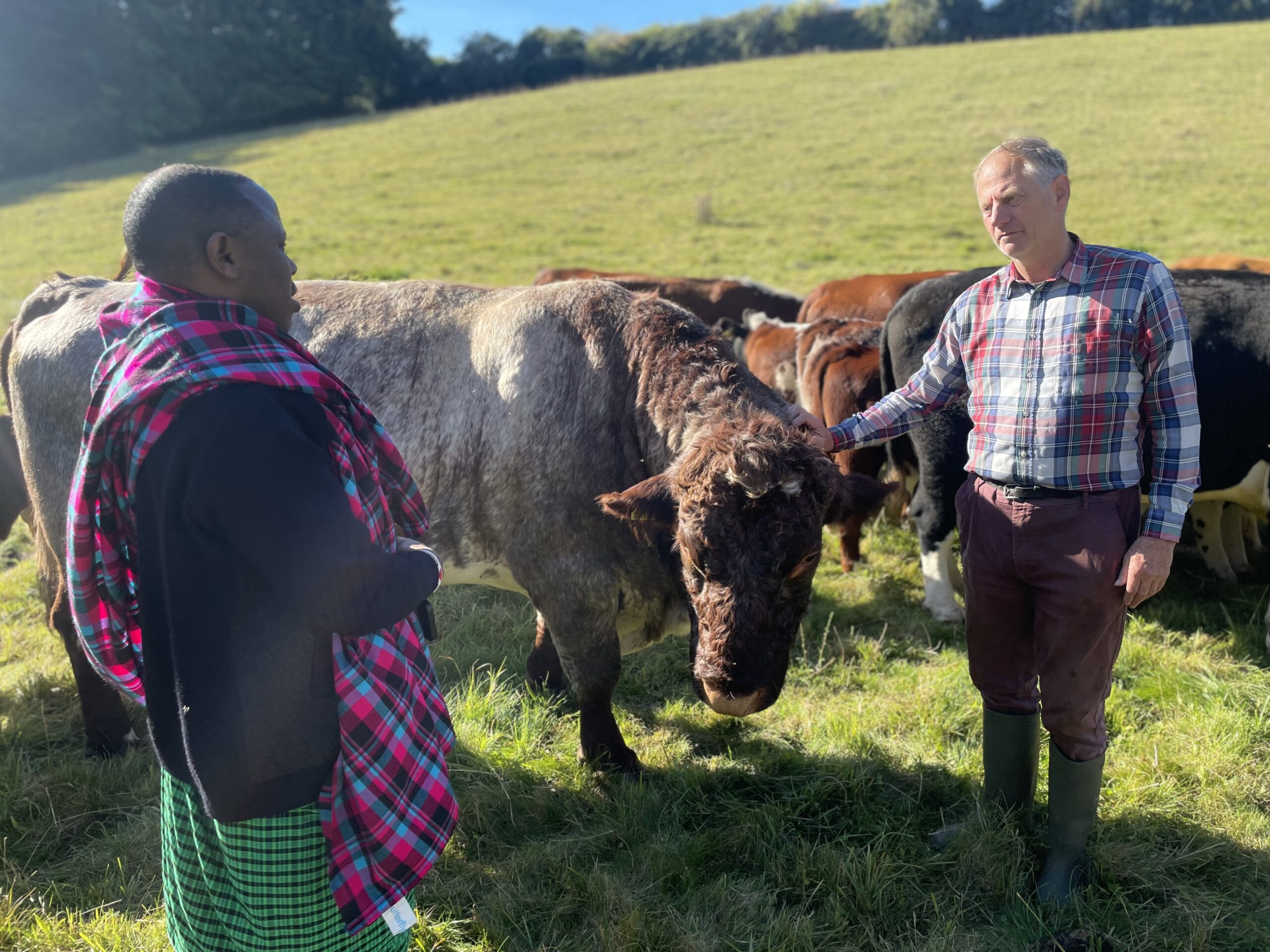
The Maasai are one of the world’s great cattle-keeping peoples, and their mythology holds that all cows were a gift to them from God. So, it came as no surprise that Sam knows his animals well, or that he was suitably impressed with James’ herd.
Sam showed photos of his own 70-strong herd of Zebu cows, explaining that external pressures are being exerted on his community to swap to imported breeds. His own recent experiments with a Sahiwal bull had resulted in poor outcomes, further confirming to him that traditional livestock are essential. James’ choice of a traditional English breed echoes Sam’s sentiments. Sam was fascinated to learn about the organic farming movement, having been led to believe the UK was dominated entirely by industrialised agriculture.
Cattle and colonialism
Bringing new cattle to East Africa was one of the mainstays of British colonial intervention.Early in the twentieth century, while many Maasai peoples were being pushed off their traditional lands and restricted in their movements, the English aristocrat Lord Delamere arrived in East Africa and began to establish himself as a prominent force in farming. Delamere experimented with lots of different breeds in his attempts to develop modern dairying in British East Africa, present-day Kenya. Many of these attempts floundered in the face of environmental stresses and diseases.
Clyde Higgs, uncle of The MERL’s founder, John Higgs, was also keen to ‘improve’ husbandry practices and breeds. Higgs was a very prominent English dairy farmer and agricultural journalist. His articles can be found in many journals within the MERL Library, including Country Life magazine. In his writing he shared thoughts about farming in both England and Tanganyika (modern-day Tanzania), dismissing the claims of local peoples in favour of English settler farmers.
Once we reached The MERL, I showed Sam albums of Higgs’ own photos from mid-twentieth-century visits to various parts of Africa. These photos featured numerous images of European, Afrikaans, and North American breeds. This new online exhibition charts some of the changes that Clyde hoped to make in Tanganyika where he farmed from the late-1940s through to the threshold of Tanzanian independence.
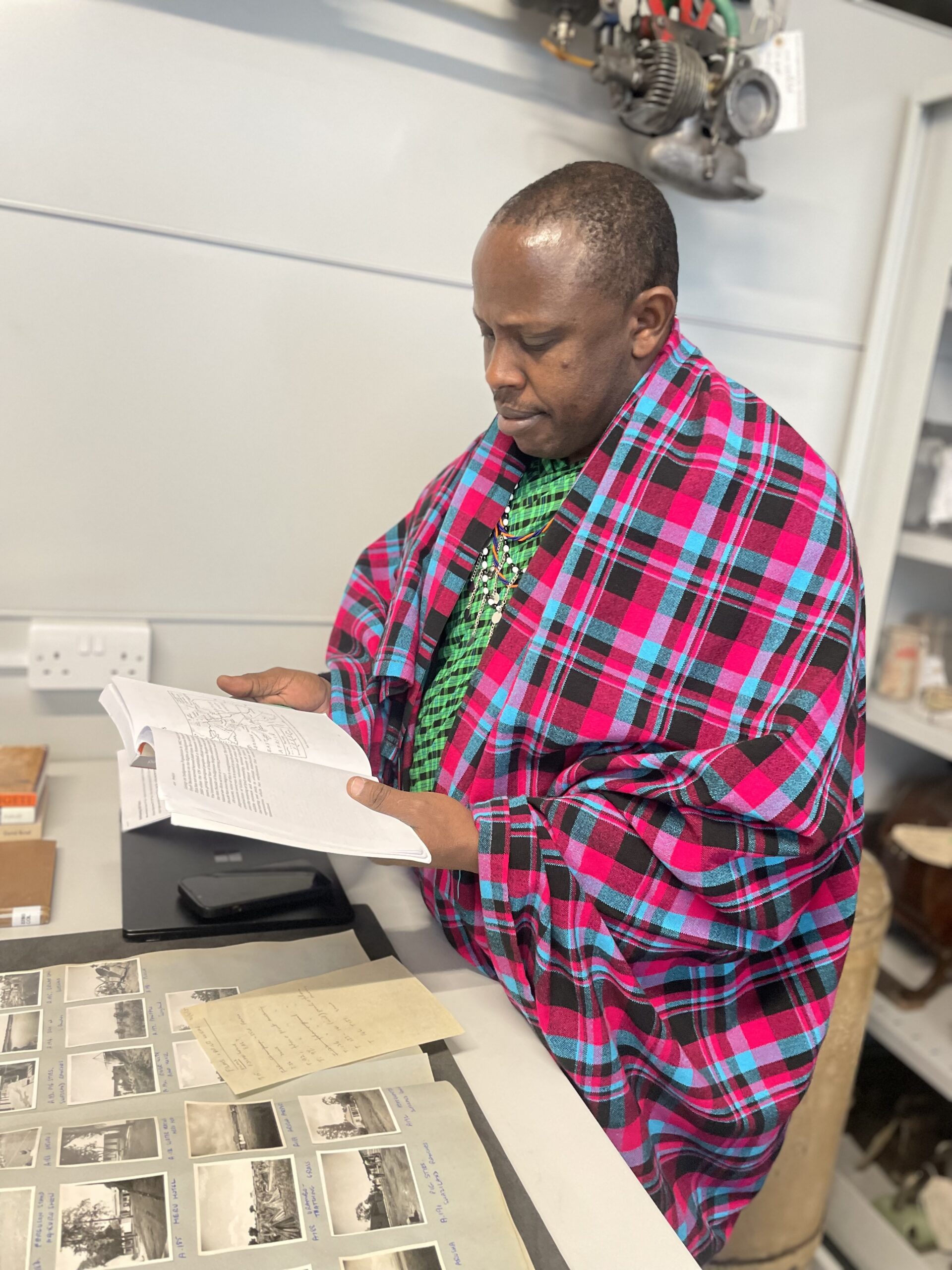
Another of our previous online exhibitions recounts the disastrous Tanganyika Groundnut Scheme, a mid-twentieth century experiment that tried to establish largescale groundnut cultivation in an unsuitable environment, ignoring the knowledge and voices of local and indigenous communities and farmers. Although this took place far from Maasai homeland, it is another perfect example of the ways in which local ideas and land claims were routinely dismissed by colonial authorities.
Within Clyde’s mid-century albums, there are also images of Maasai people close to the towns of Moshi and Arusha. Their nameless presence highlights Clyde’s disinterest in their way of life. When compared with his endless focus on imported bulls or on charting the experiences of European settler farmers, Maasai ideas about land were seen by him as secondary. Sadly, such views persist today in the attitudes of many policymakers towards the pastoralist ways of life.
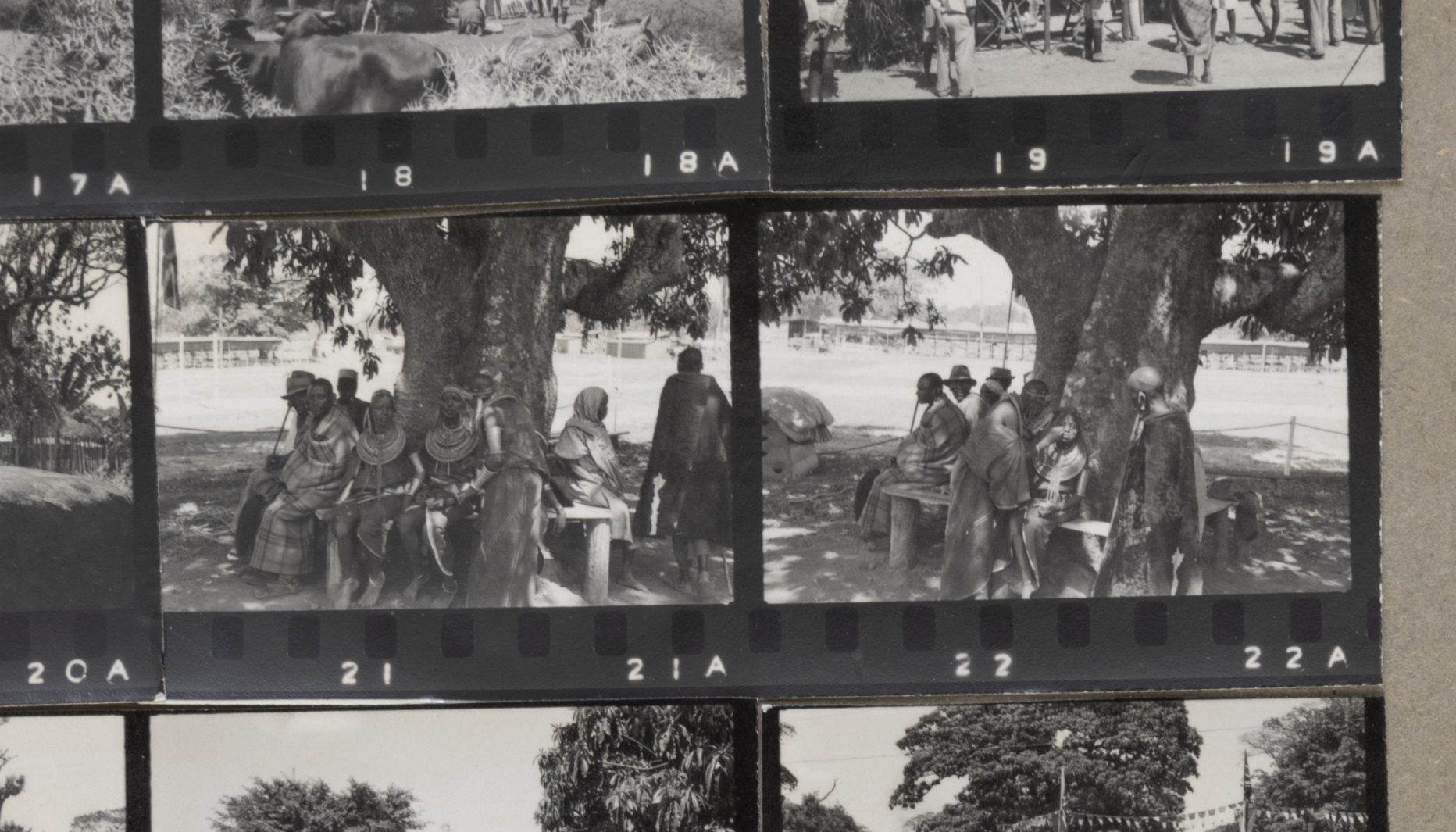
For Maasai communities, the transition to independence was not one of liberation but marked a shift from one set of settler farmer ideals and ambitions to another. As Sam explained, when Prime Minister (later President) Julius Nyerere first came to power in 1961, his vision for a productive future for his country remained very much at odds with Maasai perspectives and traditions.
Sustainable farming in Britain and Kenya
During our fascinating day together, Sam was also able to join us for a gallery tour with Dr Jen Clark (as part of our ongoing Our Green Stories series), which explored the value of trees in our lives and treescapes for climate protection.As Sam later explained, current privatisations of Maasai land in the Loita hills of Kenya (which I visited last year) may well have negative environmental consequences for trees. When government-backed enclosures were enforced elsewhere in Kenya, in Kajiado County, trees were removed at an alarming rate, leading to desertification. As a result, people lost access to watering holes and boreholes, which means drought has become a more significant risk than ever before.
As I write, the open landscapes of the Loita Hills are being fenced off. This is resulting in new ‘rights of way’ arguments for Sam’s community, who are striving to continue to cross from Tanzania, as they have always done, to visit ceremonial sites in Kenya’s Loita hills. As debates about Loita rage on, I am reminded of the deep history of campaigns about access to UK land. At The MERL we hold the archives of Britain’s longest-running organisation devoted to safeguarding rights of access to footpaths and commons, the Open Spaces Society, as founded in 1865.
After the tour, I took a moment to show Sam The MERL’s collection of eighteenth- and nineteenth-century livestock portraits, including an extraordinary volume of paintings from around 1800, in which the artist George Garrard depicted native cattle breeds of the British Isles.

Garrard also captured wider imperial connections in British livestock husbandry. An image of a bull from Ceylon (present-day Sri Lanka) and an ‘African bull’ from Sierra Leone suggest that the flow of livestock traits was not just European breeds going overseas. Indeed, long before Clyde Higgs’ enthusiasm for foreign cattle being imposed on African herders, English agricultural improvers may well have been co-opting traits from African livestock and breeding them into native British breeds.
Royal Agricultural University
We had one last stop for Sam’s visit: a drive over to Cirencester to visit the Royal Agricultural University (RAU) and meet Dr Atenchong Talleh Nkobou. Atenchong is an expert in land management and a long-time supporter of The MERL, who has previously helped us to better understand histories linking English farming to East African land concerns (including the Groundnut Scheme mentioned previously).Atenchong took us for a walk to see a delightful RAU herd of Gloucester cattle, affording a little more time communing with lovely livestock, and we then took time to discuss plans for a session exploring land, nature, and food at Oxford Real Farming Conference in January 2025.
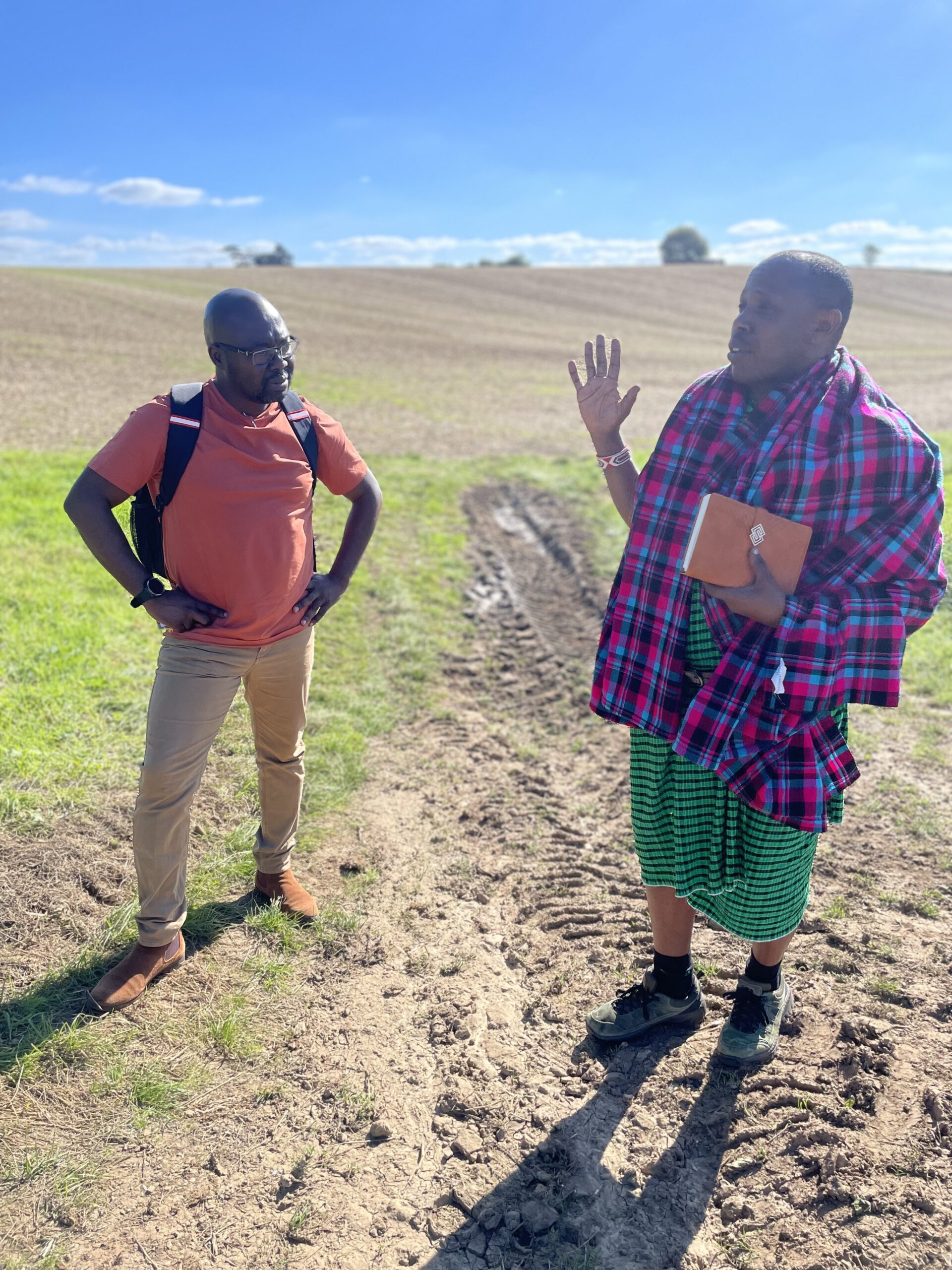
We also talked in detail about future plans to share knowledge and creative approaches to land, access, and nature. How might we work together to support Maasai people in maintaining their vital traditions and important ecologies? Can we as a museum do more to highlight the ways in which sympathetic farmers like James are working with livestock and nature?
And with a shed full of histories that serve as a warning on the impacts of enclosure, what part can we play in examining ideas about land here in England, or those about the landscapes of Tanzania and Kenya, where Sam’s heritage and future are so powerfully intertwined with our own?
Our enormous thanks to Sam for spending the day with us and sharing his experiences and knowledge.
For more information about the colonial legacy both at and of The MERL, take a look at our online exhibition that accompanies this blogpost: Snapshots of Simba Farm.
We aim for our work to reflect and platform the broad experiences of people living and working across the English countryside today. Soon, we’ll be launching a second series of posts expanding upon Changing Perspectives in the Countryside, featuring interviews with people of colour living and working in rural England today. More to come on that very soon!
